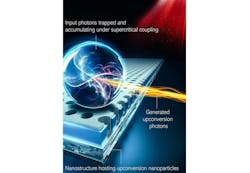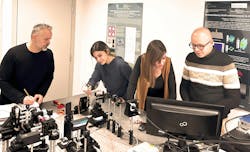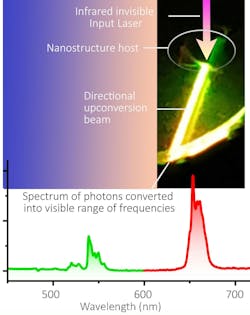A new way to trap and convert light energy via “supercritical coupling” was recently discovered by researchers from the National Research Council of Italy’s Institute of Applied Sciences and Intelligent Systems, the National University of Singapore, and the Molecular Foundry in California (see video).
The team’s supercritical coupling technique significantly improves photon upconversion efficiency and enables control of light emission—and it may help speed advances in myriad applications, such as quantum technology, high-resolution imaging, photonic devices, and optical cavities and resonators.
Photon upconversion is a nonlinear optical method to convert low-energy photons (invisible) into higher-energy ones (visible) and is used for wide-ranging applications—from super-resolution imaging to advanced photonic devices (see Fig. 1). Despite progress, the quest for efficient photon upconversion faces challenges due to inherent limitations in the irradiance of lanthanide-doped nanoparticles and their low absorption efficiencies at the wavelengths of interest.
The team’s work, led by the research groups of Gianluigi Zito, a senior research scientist at the National Research Council of Italy, and Xiaogang Liu, a professor of chemistry at the National University of Singapore, shows supercritical coupling can address these challenges (see Fig. 2).
“Light-matter interactions are a cornerstone of scientific research, central to numerous challenges in advanced technology, and enhancement of these interactions becomes possible by confining light within nanoscale volumes akin to molecular sizes,” says Liu.
Distinctive light configurations exist in which light can be captured without energy loss—and it amplifies the potential for manipulating material properties. “But mastering these specialized photonic modes known as bound states in the continuum (BICs) poses a formidable challenge because it isn’t easy to active them, which results in a bottleneck,” says Zito.
Harnessing bound states in the continuum
The team set out to overcome limitations associated with light energy confinement within BIC modes. And mathematical principles governing the formation of unique light configurations unveiled an optimal condition: supercritical coupling.
Two infrared (IR) photons of low energy can be converted into a single photon of double energy, which becomes visible to the human eye. “This is an example of energy conversion of photons, which has myriad applications,” says Liu. “But it’s only possible by taking advantage of a material platform in which the material’s electrons mediate the conversion process.”
One big challenge is that the physical mechanism of interaction of an input photon with the material’s electrons is inefficient. To enhance efficiency, the interaction must be intensified by physically confining the photons, which makes them oscillate within a confined space and increases the likelihood of contact with electrons. Because the electrons involved belong to a specialized class of nanoparticles—spanning the size of a few thousand atoms—they’re engineered to possess energy levels conducive to generating the desired visible photons.
“Our work demonstrates how to efficiently trap light—without physical barriers—inside a tiny open cavity. Inside this cavity, photons oscillate and reflect without any real mirrors,” Zito explains. “This is possible when light achieves a singular configuration—a new concept of physics we’ve shown can be activated in an efficient way.”
How does it work?
In the team’s experimental setup, input IR photons of a titanium-sapphire femtosecond laser are trapped inside a nanostructure with the upconversion nanoparticles (see Fig. 3). The nanodevice host creates the singular condition for light trapping, and the trapped photons oscillate thousands of times and eventually interact with the electrons, which convert them into new photons with higher energy.
Once liberated from the trapping mechanism, “these higher-energy photons are no longer constrained and can exit the system ready to be harnessed for various purposes,” says Zito. “The spectral analysis of photons is achieved by using an optical spectrometer.”
Despite its microscale size, the team’s upconversion beam is highly directional, which is the result of the nanostructure’s BIC that simultaneously excite numerous nanoparticles. This synchronous excitation induces a collective interference of the converted photons and compels them to traverse a precise and well-defined pathway.
“In essence, our work not only pushes the boundaries of what was previously possible, but also offers tangible and far-reaching benefits for advancement of photonics technology,” says Zito. “The primary focus of our work revolves around the groundbreaking achievement of harnessing bound states in the continuum within photonic nanostructures—a fascinating mechanism of light trapping.”
The team’s work led to a remarkable enhancement in the emission of upconversion photoluminescence—surpassing previous limits. Its significance lies not only in the sheer magnitude of improvement, but also the newfound ability to precisely control the direction of emission.
Being able to control the direction of emission represents a paradigm shift in photonics. This feature introduces a once-elusive level of precision and versatility—and enables tailored applications in imaging, communications, and sensing technologies.
“A special moment occurred when we observed a significant increase in the emission of upconversion photoluminescence that surpassed our initial expectations—and we realized it was consistent with our theory,” says Zito.
Looking at such a bright microscoping light, via naked eye, generated by a tiny number of nanoparticles was “absolutely incredible,” Zito adds. “Being able to control the direction of emission added to the moment. It was thrilling to realize the practical implications of this control—it marks a pivotal advance in manipulating light at the nanoscale, akin to unlocking a door to a realm of possibilities previously unseen.”
Challenges to overcome
It’s important to acknowledge the challenges the team encountered and the ones still ahead. The biggest one is that ensuring the stability and reliability of this mechanism using BICs within photonic nanostructures will be critical for practical applications.
“Optimizing the efficiency of the process is an ongoing pursuit that requires fine-tuning the parameters to maximize the emission and control it throughout several possible scenarios,” says Zito. “We need to address all of the factors that may affect the reliable exploitation of these states, such as material properties, and it’s a challenge we continue to tackle.”
Scaling their method and real-world applications are both serious challenges that will involve overcoming potential scalability issues.
“Adapting our technology for broader use—without compromising performance—is an ongoing area of research,” Liu says. “Compatibility and experimental demonstration within diverse fields requires a collaborative and multidisciplinary approach. Overcoming these hurdles will validate the potential of our work and also pave the way for its practical use.”
Applications galore
The team’s photon upconversion method is poised to advance medical imaging technologies by enabling more sensitive and higher-resolution imaging for diagnostics. Its precise control over emission directionality can enhance the accuracy and depth of imaging of biological tissues.
And the method’s ability to control the direction of emission has implications for optical comms. “Our work may contribute to the development of more efficient and secure optical comms systems with enhanced signal integrity and reduced interference,” says Zito.
It also holds promise for sensing technologies, particularly for developing highly sensitive and selective sensors for various environmental and biomedical applications, because increased emission and directional control can enhance the capabilities of sensors for detecting specific substances or conditions.
Efficient control of photon emission can also be applied to energy-harvesting devices, where the increased photoluminescence can be harnessed for improved solar cells or other light-to-energy conversion technologies.
“And the ability to manipulate and control photons at the nanoscale is significant for the development of quantum technologies,” says Zito. “Our work may contribute to the creation of more advanced quantum computation and comms devices.”
How about LEDs and displays? Yes—it can be leveraged to develop more efficient and customizable light-emitting devices like LEDs and displays by enhancing their emission properties and directing light with precision.
Photonic integrated circuits? Also yes. “The directional control of emission is valuable for the design of photonic integrated circuits because it enables the creation of compact and efficient devices for information processing and transmission,” Zito says.
And its enhanced emission capabilities and directionality control look promising for biophotonics applications because it has the potential to enable advanced studies of cellular processes, bioimaging, and optogenetics. “These applications are just a glimpse of the potential of our work within diverse fields,” Zito says.
What’s next?
The team’s research will now focus on “fine-tuning the parameters and exploring novel materials,” says Zito. “Our goal is to expand the range of applications and improve the overall performance of our photonics platform by making it more versatile so it can be more easily integrated into several existing technologies.”
They’ll explore new domains where their approach can make significant contributions—with the potential to uncover unforeseen applications in areas such as quantum computing, energy storage, and beyond.
“Sharing our findings with the scientific community and the broader public is essential—we’ll continue to share our knowledge, which will hopefully inspire new research directions and foster a deeper understanding of the potential impact of our work,” Zito says.
FURTHER READING
C. Schiattarella et al., Nature, 626, 765–771 (2024); https://doi.org/10.1038/s41586-023-06967-9.



